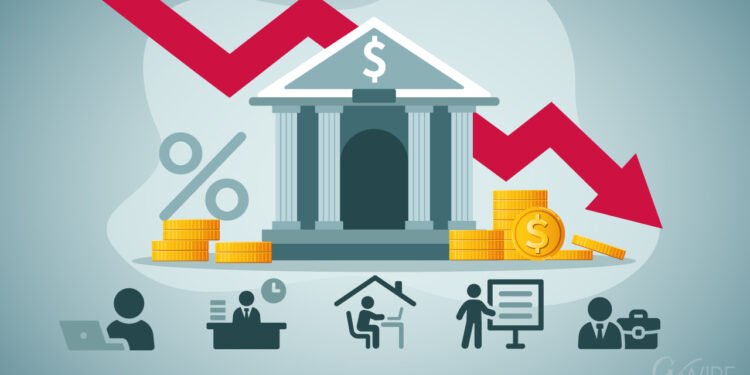Ghanaian borrowers are breathing a sigh of relief as the average lending rates across the country have fallen sharply, providing a welcome boost to businesses and households alike.
According to the Bank of Ghana’s (BoG) November 2025 Summary of Economic and Financial Data, the average cost of borrowing stood at 22.22% in October 2025, marking a significant decline from 30.07% at the start of the year.
This dramatic reduction reflects the effects of sound monetary policy, strong economic growth, and improvements in Ghana’s external financial buffers. It also signals a more accessible credit environment for individuals, small businesses, and larger corporations seeking financing for growth.
Lending Rates: A Journey of Decline
The decline in average lending rates has been steady but punctuated by small fluctuations. In January 2025, the average rate was 30.07%, before rising slightly to 30.12% in February. This was followed by gradual decreases: 29.18% in March, 27.40% in April, and 26.90% in May. A marginal uptick to 27.00% in June was observed, but thereafter, lending rates fell consistently, culminating in the October rate of 22.22%.
Similarly, the Ghana Reference Rate (GRR), which guides the overall pricing of loans in the banking sector, also fell sharply from 29.72% in January to 17.86% in October 2025. The decline in the GRR underscores the central bank’s commitment to disinflationary policies while promoting economic growth.
The reduction in lending rates reflects sustained disinflation, strong growth, and the bolstering of external reserves. It is the hope that lower borrowing costs will translate into more affordable credit for households and businesses.
Implications for Businesses and Households
The sharp fall in lending rates has important implications for Ghana’s economy. For businesses, particularly small and medium-sized enterprises (SMEs), lower borrowing costs reduce the financial burden of loans, freeing up capital for investment in expansion, innovation, and job creation.
The reduction in interest rates is a game-changer for businesses. It means that businesses can access working capital more easily and plan for new projects without worrying excessively about high financing costs.
For households, the decline in rates offers relief on personal loans, mortgages, and other forms of credit. Lower rates can enhance consumer spending, stimulate demand in key sectors like housing and retail, and ultimately contribute to overall economic growth.
While the average lending rate has dropped significantly, rates still vary widely among banks and sectors. Some financial institutions now offer loans at rates close to the Ghana Reference Rate, around 18%, whereas others continue to charge as high as 39%, depending on the borrower’s risk profile.
This variation underscores the importance of evaluating bank offers carefully. Borrowers with strong credit histories and lower risk may benefit from the lowest available rates, while higher-risk borrowers may still face relatively higher costs.
Financial analysts suggest that competition among banks could intensify as more borrowers seek the most affordable credit. This could further drive down lending rates and widen access to finance across the economy.
Policy Decisions Driving the Decline
The central factor behind the decline in borrowing costs is the Bank of Ghana’s monetary policy decisions. In September 2025, the BoG cut its policy rate to 21.50%, citing sustained disinflation, robust economic growth, and improvements in the country’s external buffers.
This policy decision effectively reduced the cost of funds for banks, allowing them to extend loans to businesses and households at lower rates. Moreover, it signals the central bank’s focus on balancing inflation control with economic stimulus—a strategy that appears to be yielding tangible results.
The reduction in lending rates represents an opportunity for Ghana’s economy to accelerate growth, stimulate investment, and enhance financial inclusion. If sustained, the lower cost of borrowing could support infrastructure development, boost SME expansion, and increase employment opportunities.
However, policymakers and banks must remain vigilant. The decline in lending rates should be complemented with prudent credit risk management to ensure that growth in lending does not lead to a surge in non-performing loans.
While lower lending rates are encouraging, responsible borrowing and lending practices remain crucial for maintaining financial stability and sustaining economic growth.
READ ALSO:Bank of Ghana Slashes Policy Rate by 350 Basis Points to 18%, Signaling Major Economic Boost























